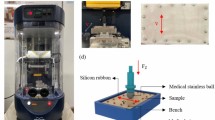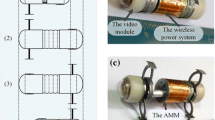Abstract
There are serious friction damage problems that few studies have focused on when conveying endoscope to the lesion locations. In this paper, the friction behavior between endoscope and esophageal mucosa tissue which stretched in different directions was studied by using a UMT-II Micro-Tribometer. Results show that the friction coefficient and energy dissipation decreased with the increasing circumferential strain, and enhanced with the increasing axial strain. The difference in friction behaviors was related to the structural and mechanical anisotropy of the esophageal tissue. The tearing degree on the mucosal surface gradually increased with the increasing normal force. Lidocaine could effectively reduce the friction dissipation and damage. The results can provide the basic data for safety operation and damage control during endoscopy.















Similar content being viewed by others
References
Cohen, L.B., Wecsler, J.S., Gaetano, J.N., et al.: Endoscopic sedation in the United States: results from a nationwide survey. Am. J. Gastroenterol. 101, 967 (2006)
Gotoda, T., Yamamoto, H., Soetikno, R.M.: Endoscopic submucosal dissection of early gastric cancer. J. Gastroenterol. 41, 929–942 (2006)
Ono, H., Kondo, H., Gotoda, T., et al.: Endoscopic mucosal resection for treatment of early gastric cancer. Gut. 48, 225 (2001)
Adler, D.G., Baron, T.H., Davila, R.E., et al.: ASGE guideline: the role of ERCP in diseases of the biliary tract and the pancreas. Gastrointest. Endosc. 62, 1–8 (2005)
Valdastri, P., Simi, M., Webster, I.I.I.R.J.: Advanced technologies for gastrointestinal endoscopy. Ann. Rev. Biomed. Eng. 14, 397–429 (2012)
Ciuti, G., Menciassi, A., Dario, P.: Capsule endoscopy: from current achievements to open challenges. IEEE Rev. Biomed. Eng. 4, 59–72 (2011)
Jentschura, D., Raute, M., Winter, J., et al.: Complications in endoscopy of the lower gastrointestinal tract. Surg. Endosc. 8, 672–676 (1994)
Eisen, G.M., Baron, T.H., Dominitz, J.A., et al.: Complications of upper GI endoscopy. Gastrointest. Endosc. 55, 784–793 (2002)
Wang, X., Meng, M.Q.H.: Study of frictional properties of the small intestine for design of active capsule endoscope// ieee/ras-embs international conference on biomedical robotics and biomechatronics. IEEE. 124–129: (1996)
Kim, J.S., Sung, I.H., Kim, Y.T.: Experimental investigation of frictional and viscoelastic properties of intestine for micro-endoscope application. Tribol. Lett. 22, 143–149 (2006)
Wang, X., Meng, M.Q.H., Chan, Y.: Physiological factors of the small intestine in design of active capsule endoscopy//Engineering in Medicine and Biology Society, 2005, IEEE-EMBS 2005, 27th Annual International Conference of the. IEEE. 2942–2945: (2006)
Wang, X., Meng, M.Q.H.: An experimental study of resistant properties of the small intestine for an active capsule endoscope, Proceedings of the Institution of Mechanical Engineers, Part H: Journal of Engineering in Medicine. 224, 107–118: (2010)
Woo, S.H., Kim, T.W., Cho, J.H.: Stopping mechanism for capsule endoscope using electrical stimulus. Med. Biol. Eng. Comput. 48, 97–102 (2010)
Zhang, C., Liu, H., Li, H.: Experimental investigation of intestinal frictional resistance in the starting process of the capsule robot. Tribol. Int. 70, 11–17 (2014)
Lee, S.H., Kim, Y.T., Yang, S., et al.: An optimal micropatterned end-effecter for enhancing frictional force on large intestinal surface. ACS Appl. Mater. Interf. 2, 1308–1316 (2010)
Accoto, D., Stefanini, C., Phee, L., et al.: Measurements of the frictional properties of the gastrointestinal tract. World Tribol. Congr. 3, 7 (2001)
Kim, J.S., Sung, I.H., Kim, Y.T.: Analytical model development for the prediction of the frictional resistance of a capsule endoscope inside an intestine. Proc. Inst. Mech. Eng. 221, 837–845: (2007)
Zhang, C., Liu, H., Tan, R., et al.: Modeling of velocity-dependent frictional resistance of a capsule robot inside an intestine. Tribol. Lett. 47, 295–301 (2012)
Woo, S.H., Kim, T.W., Mohy-Ud-Din, Z., et al.: Small intestinal model for electrically propelled capsule endoscopy. Biomed. Eng. Online 10, 108 (2011)
Woods, S.P., Constandinou, T.G.: Wireless capsule endoscope for targeted drug delivery: mechanics and design considerations. IEEE Trans. Biomed. Eng. 60, 945–953 (2013)
Gao, P., Yan, G., Wang, Z., et al.: A robotic endoscope based on minimally invasive locomotion and wireless techniques for human colon. Int J Med Robot Comput Assist Surg. 7, 256–267 (2011)
He, S., Yan, G., Gao, J., et al.: Frictional and viscous characteristics of an expanding–extending robotic endoscope in the intestinal environment. Tribol. Lett. 58, 36 (2015)
Yang, W., Fung, T.C., Chian, K.S., et al.: Directional, regional, and layer variations of mechanical properties of esophageal tissue and its interpretation using a structure-based constitutive model. J. Biomech. Eng. 128, 409 (2006)
Natali, A.N., Carniel, E.L., Gregersen, H.: Biomechanical behaviour of oesophageal tissues: material and structural configuration, experimental data and constitutive analysis. Med. Eng. Phys. 31, 1056–1062 (2009)
Yang, J., Zhao, J., Liao, D., et al.: Biomechanical properties of the layered oesophagus and its remodelling in experimental type-1 diabetes. J. Biomech. 39, 894–904 (2006)
Yang, W., Fung, T.C., Chian, K.S., et al.: 3D mechanical properties of the layered esophagus: experiment and constitutive model. J. Biomech. Eng. 128, 899–908 (2006)
Lin, C.X., Yu, Q.Y., Wang, J., et al.: Friction behavior between endoscopy and esophageal internal surface. Wear. 376, 272–280 (2017)
Correia, N.T., Ramos, J.M., Saramago, B.J.V., et al.: Estimation of the surface tension of a solid: application to a liquid crystalline polymer. J. Coll. Interf. Sci 189, 361–369 (1997)
Stauffer, C.E.: The measurement of surface tension by the pendant drop technique. J. Phys. Chem. 69, 1933–1938 (1965)
Kwiatkowska, M., Franklin, S.E., Hendriks, C.P.: Friction and deformation behaviour of human skin. Wear 267, 1264–1273 (2009)
Fung, Y.: Biomechanics: mechanical properties of living tissues, 2 edn. Springer, New York (2013)
Gregersen, H., Kassab, G.: Biomechanics of the gastrointestinal tract. Neurogastroenterol. Motil. 8, 277–297 (1996)
Stachowiak, G., Batchelor, A.W.. Engineering tribology. Butterworth Heinemann, Oxford (2013)
Stupkiewicz, S., Lewandowski, M.J., Lengiewicz, J.: Micromechanical analysis of friction anisotropy in rough elastic contacts. Int. J. Solids Struct. 51, 3931–3943 (2014)
Leyva-Mendivil, M.F., Lengiewicz, J., Page, A., et al.: Skin microstructure is a key contributor to its friction behaviour. Tribol. Lett. 65, 12 (2017)
Derler, S., Huber, R., Feuz, H.P., et al.: Influence of surface microstructure on the sliding friction of plantar skin against hard substrates. Wear 267, 1281–1288 (2009)
Moore, D.F.: The friction and lubrication of elastomers. Pergamon Press, Oxford (1972)
Wolfram, L.J.: Friction of skin. JSCC 34, 465 (1983)
Hendriks, C.P., Franklin, S.E.: Influence of surface roughness, material and climate conditions on the friction of human skin. Tribol. Lett. 37, 361–373 (2010)
Gefen, A.: How do microclimate factors affect the risk for superficial pressure ulcers: a mathematical modeling study. J. Tissue Viability 20, 81–88 (2011)
Sokolis, D.P., Kefaloyannis, E.M., Kouloukoussa, M., et al.: A structural basis for the aortic stress–strain relation in uniaxial tension. J. Biomech. 39, 1651–1662 (2006)
Vanags, I., Petersons, A., Ose, V., et al.: Biomechanical properties of oesophagus wall under loading. J. Biomech. 36, 1387–1390 (2003)
Derler, S., Gerhardt, L.C., Lenz, A.: Friction of human skin against smooth and rough glass as a function of the contact pressure. Tribol. Int. 42, 1565–1574 (2009)
Tang, W., Ge, S., Zhu, H., et al.: The influence of normal load and sliding speed on frictional properties of skin. J. Bionic Eng. 5, 33–38 (2008)
Tay, B.K., Kim, J., Srinivasan, M.A.: In vivo mechanical behavior of intra-abdominal organs. IEEE Trans. Biomed. Eng. 53, 2129–2138 (2006)
Yang, W., Fung, T.C., Chian, K.S., et al.: Viscoelasticity of esophageal tissue and application of a QLV model. J. Biomech. Eng. 128, 909–916 (2006)
Adams, M.J., Briscoe, B.J., Johnson, S.A.: Friction and lubrication of human skin. Tribol. Lett 26, 239–253 (2007)
Acknowledgements
This work was supported by National Natural Science Foundation of China (No. 51675447 and No. 51290291).
Author information
Authors and Affiliations
Corresponding author
Rights and permissions
About this article
Cite this article
Lin, C.X., Li, W., Deng, H.Y. et al. Friction Behavior of Esophageal Mucosa Under Axial and Circumferential Extension. Tribol Lett 67, 9 (2019). https://doi.org/10.1007/s11249-018-1123-x
Received:
Accepted:
Published:
DOI: https://doi.org/10.1007/s11249-018-1123-x




